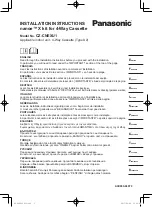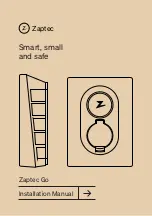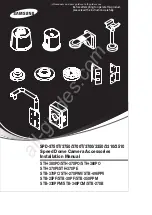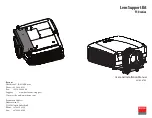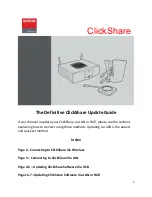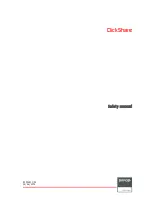
21
be established within three (3) consecutive ignition
attempts. If flame is not established within the seven (7)
second trial for ignition, the gas valve is de-energized,
15 second inter-purge cycle is completed, and ignition
is reattempted. The control will repeat this routine three
times if a measurable combustion is not established. The
control will then shut off the induced draft blower and go
into a lockout state.
If flame is established but lost, the control will energize
the circulator blower at the heat speed and then begin a
new ignition sequence. If flame is established then lost
on subsequent attempts, the control will recycle for four
(4) consecutive ignition attempts (five attempts total)
before locking out.
The diagnostic fault code is 1 flash for a lockout due to
failed ignition attempts or flame dropouts. The integrated
control will automatically reset after one hour, or it can be
reset by removing the thermostat signal or disconnecting
the electrical
power supply for over five seconds. If the
diagnostic LED indicates an external lockout, perform
the following checks:
•
Check the supply and manifold pressures
•
Check the gas orifices for debris
•
Check gas valve for proper operation
•
Check secondary limit
A dirty filter, excessive duct static, insufficient air
flow, a faulty limit, or a failed circulator blower can
cause this limit to open. Check filters, total external
duct static, circulator blower motor, blower motor
speed tap (see wiring diagram), and limit. An
interruption in electrical power during a heating
cycle may also cause the auxiliary limit to open.
The automatic reset secondary limit is located on
top of the circulator blower assembly.
•
Check rollout limit
If the burner flames are not properly drawn into
the heat exchanger, the flame rollout protection
device will open. Possible causes are restricted
or blocked flue passages, blocked or cracked
heat exchanger, a failed induced draft blower, or
insufficient combustion air. The rollout protection
device is a manual reset limit located on the burner
bracket. The cause of the flame rollout must be
determined and corrected before resetting the limit.
•
Check flame sensor
A drop in flame signal can be caused by nearly
invisible coating on the sensor. Remove the sensor
and carefully clean with steel wool.
•
Check wiring
Check wiring for opens/shorts and miswiring.
Important:
If you have to frequently reset your gas/
electric package unit, it means that a problem exists
that should be corrected. Contact a qualified servicer
for further information.
Pressure Switch Stuck Open
A pressure switch stuck open can be caused by a faulty
pressure switch, faulty wiring, a disconnected or damaged
hose, a blocked or restricted flue, or a faulty induced
draft blower.
If the control senses an open pressure switch during the
pre-purge cycle, the induced draft blower only will be
energized. If the pressure switch opens after ignition
has begun the gas valve is de-energized, the circulator
blower heat off cycle begins, and the induced draft blower
remains on. The diagnostic fault code is two flashes.
Pressure Switch Stuck Closed
A stuck closed pressure switch can be caused by a faulty
pressure switch or faulty wiring. If the control encounters
a pressure switch stuck closed, the induced draft blower
remains off. The diagnostic LED code for this fault is
three (3) flashes.
Open Thermal Protection Device
If the primary limit switch opens, the gas valve is
immediately de-energized, the induced draft and air
circulating blowers are energized. The induced draft
and air circulator blowers remain energized until the limit
switch recloses. The diagnostic fault code for an open
limit is four (4) flashes.
A primary limit will open due to excessive supply air
temperatures. This can be caused by a dirty filter, excessive
duct static, insufficient air flow, or a faulty limit. Check
filters, total external duct static, blower motor, blower motor
speed
tap (see wiring diagram), and limit. This limit will
automatically reset once the temperature falls below a
preset level.
Primary Limit
A primary limit will open due to excessive supply air
temperatures. This can be caused by a dirty filter,
excessive duct static, insufficient air flow, or a faulty limit.
Check filters, total external duct static, blower motor,
blower motor speed tap (see wiring diagram), and limit.
This limit will automatically reset once the temperature
falls below a preset level.
Auxiliary/Secondary Limit
A dirty filter, excessive duct static, insufficient air flow, a
faulty limit, or a failed circulator blower can cause this limit
to open. Check filters, total external duct static, circulator
blower motor, blower motor speed tap (see wiring
diagram), and limit. An interruption in electrical power
during a heating cycle may also cause the auxiliary limit
to open. The automatic reset secondary limit is located
on top of the circulator blower assembly.
Rollout Limit
If the burner flames are not properly drawn into the heat
exchanger, the flame rollout protection device will open.
Possible causes are restricted or blocked flue passages,
blocked or cracked heat exchanger, a failed induced
draft blower, or insufficient combustion air. The rollout
protection device is a manual reset limit located on the
burner bracket. The cause of the flame rollout must be
determined and corrected before resetting the limit.
Flame Detected with Gas Valve Closed
If flame is detected with the gas valve de-energized, the
combustion and air circulator blowers are energized. The
diagnostic fault code is five (5) flashes for this condition.
The control can be reset by removing the power supply
to the unit or it will automatically reset after one hour.
Miswiring is the probable cause for this fault.































